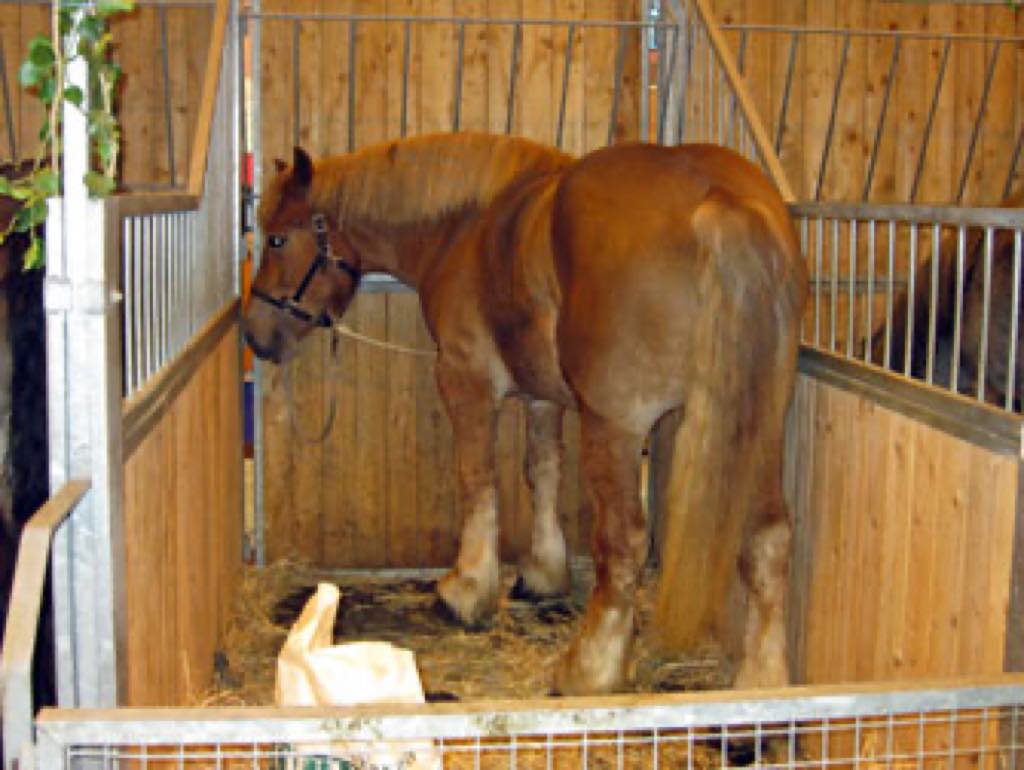
I went over the checklist one more time: Sturdy shoes? Check. Stain- and rip-resistant clothes? Check. High-capacity carryall? Check. Large amount of cash in small bills? Check. Empty stomach? Check. Empty bladder? Check.
A frisson of anticipation washed over me as I locked the apartment door and headed down the stairs. I didn’t know exactly what lay ahead. I didn’t know when I would be back. But I was ready. Ready to brave the hordes, ready to endure the hardships… ready to face the beasts.
On my annual pilgrimage to the Salon de l’Agriculture, that is. Called the “Paris International Agricultural Show” in English, this massive, multifarious festival of the farm is held every February at the Porte de Versailles Convention Center, this year running through March 4.
The first thing I did upon arrival was get a press kit, from which I learned that the Salon, now in its 49th year, draws hundreds of thousands of visitors to see thousands of stands exhibiting thousands of products, thousands of plants and, most importantly, thousands of live animals.
The official info sheet claims that, during the nine-day fair, the latter consume 100 tons of hay, 126 tons of silage and other feed for the cows, just over a ton of pellets for the pigs, and half a ton of grains for the goats. Then it goes on to say that they produce 280 tons of manure.
Anyone do the math? Apparently the animals’ manure output exceeds their feed intake by more than 50 tons. Why the discrepancy? Do they save it up for the trip to Paris? Or, more likely, do their owners save it up for the trip to Paris?
I also learned from the press booklet that the Salon’s poster cow this year is a multiple prizewinner named Valentine, whose dam Primevere has been rated one of the top 40 cows of her breed, and whose sire is recognized as one of the finest, and busiest, breeding bulls in France. He has this way of peering deep into your eyes and making you feel like you’re the only heifer on earth. His name, appropriately enough, is Relief.
The farmer who owns Valentine is described as having a “passion for natural breeding.” Well, good for him, I say. I know a whole lot of guys who fit that description, and none of them ever got a championship cow out of it.
Armed with all of this information, I set out to have a look around. In last year’s C’est Ironique about the SdA, I concentrated mostly on the tongue-boggling variety of ready-to-eat, or at least ready-to-cook, food products on offer at the fair. So this time I decided to take a different tack and focus on the not-ready-to-eat-or-cook-because-they’re-still-breathing meat products occupying the livestock exhibits.
My first stop was Pavilion 4, which houses the horses. As I arrived, a select set of steeds were strutting, or at least trotting, their stuff in an arena at the back.
I’m not sure what the judging criteria are at the Salon de l’Agriculture, but as far as I could see, this was a competition with only one event: running around in circles. It seemed to be the equine monathlon. Have a look at this video:
That’s it. That’s all they, or any of the other horses, did during the entire time I was watching.
I’m not sure if it’s another official event or not, but coinciding perfectly with the time span during which the announcer was announcing the announcement that the gray horse in that video had won a Best of Breed prize, he had his tail in the air and was busy extruding a measurable percentage of the above-mentioned 280-ton road apple harvest. Showing his form, so to speak.
I soon had had my fill of watching horses empty themselves and headed for Pavilion 1 to see what the unshod, edible ungulates were up to. The cattle also have their own arena at the fair, and they also put on a show. If you want to call it that:
Unlike the horses, the cows don’t just run around in circles. They walk around in circles.
There are two unfortunate anomalies in my poor-quality video, one obvious and one not so obvious. The obvious one is the annoying vertical lines (from fluorescent lighting?). And did you happen to notice the blue cow “mascot” in the background? Here she is up close:

To answer the obvious question, yes, that is an udder down there. Although, seen from the side…

…our cow looks more like a bull with a passion for natural breeding. Note to cow suit designers: flesh pink is a terrible color choice for the udder. Let’s just stick with white from now on, shall we?
Across the way from the cow ring was another, even larger arena where another competition was in progress: the Ovinpiades — the French “Olympic games” of sheepherding. In the phase of the tournament that I happened to catch, aspiring young shepherds were loading sheep into little carts hitched to all-terrain quads and then chauffeuring them around an ovine slalom course:
I don’t mean any disrespect to the entrant here. I’m sure she gave it her all and will need these skills in what I hope will be a long and successful career in the lamb chop industry, but as a spectator sport, this was on par with watching the minor league rock-paper-scissors semifinals.
Despite that fact, there was a sizable crowd of spectators in the stands and, for some reason, no fewer than four TV camera operators, and everyone was raptly following the proceedings like a bunch of… Like a bunch of… Hmm. A bunch of some kind of animal. Let me think about it…
Meanwhile, on the opposite side of the pavilion, the action in the hog ring was reaching fever pitch. Well, okay, let me put it this way: there was a hog ring and there was some action in it. Here again, there was a difference in the presentation: while the horses and cows went around in circles, the prize pigs did their best to whip the audience into a frenzy by wandering around aimlessly:
Each contender had a whole team of handlers playing pig pong with those big wooden paddles, I suppose to keep the boars from seeing each other and turning the porcine beauty pageant into a snout jousting match. As I understand it, a boar tends to perceive any other studhog as a threat to his turf. Which may consist entirely of mud, muck, slop and sewage, but hey – it’s his.
Not wishing to encroach any longer on the borders of boar territory, I went back to Pavilion 4, where the dog show had started. Here at last there seemed to be a modicum of skill involved in the competition:
The key word here is “modicum.” This may not seem like it was much of an exertion for the dogs, but they really put everything they had into it. Especially this competitor:
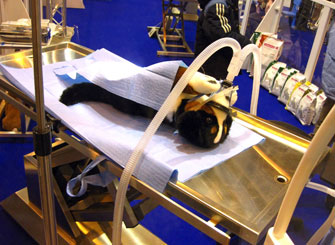
Actually, this was a nearby display conceived to teach children about “what happens to Rex and Fluffy at the vet’s.” But what I think it probably taught most of them, especially the ones with bedrooms full of stuffed animals, was “what to have a nightmare about tonight. And tomorrow night.”
By this point I was beginning to daydream about my main motivation for going to the SdA in the first place: it was time to head for the food stands in Pavilion 7.
But to get there I had to go back through Pavilion 4 and cut through Pavilion 2, and along the way it occurred to me: there seemed to be a great many displays at the agriculture expo that had nothing to do with agriculture.
At least not directly — like this one, for instance:
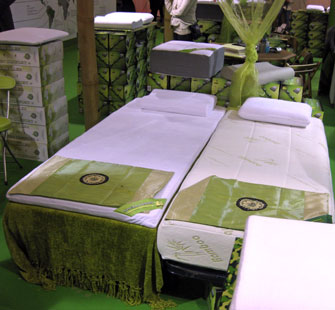
Well, I guess a farmer needs a nice, comfy bed. Especially when he’s exhausted after a long day of indulging his passion for natural breeding.
And that wasn’t the only one. There were stands offering beauty products, vacuum cleaners, ladders taller than any barn or silo I have ever seen and print-your-own-slogan sweatshirts. Strangest of all, there were a great many stands in Pavilion 4 devoted to hunting: hunting clothes, hunting hats, hunting boots, hunting knives, and even hunting horns:
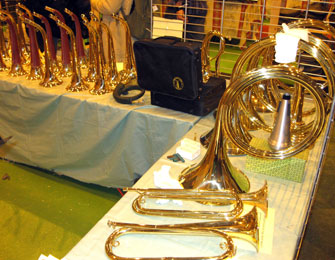
I have a question here: isn’t hunting sort of like, kind of like, ahhhh, the exact precise opposite of agriculture? As in the phrase “hunting and gathering”?
Presuming that there is such a thing as a Paris International Hunting Show, does the Salon de la Chasse have stands selling plows? I doubt it.
But no matter — I was determined to do my own hunting and gathering of French regional specialty foods. Pavilion 7 was filled with the usual SdA offerings. There were the stands of companies whose business is squishing grapes and letting that stuff sit around until it’s all fermented:
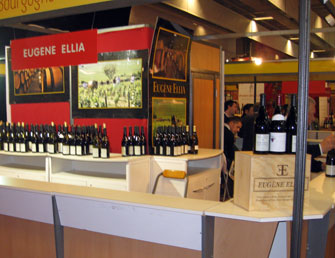
And there were the stands for companies whose business is draining cows and letting that stuff sit around until it’s all curdled:
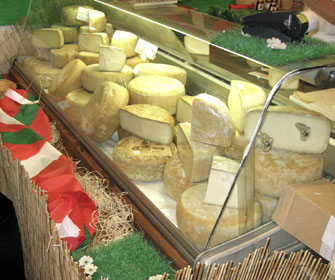
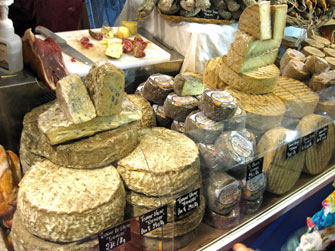
And then there were the stands for companies whose business is apparently running pigs through a wood chipper:
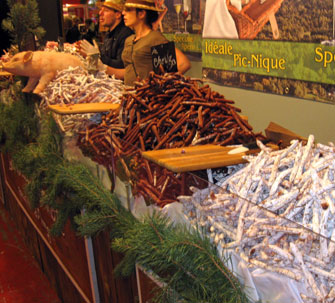
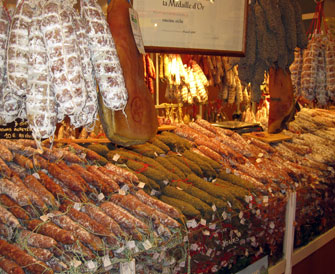
Digression alert! The young man manning the first cheese stand depicted above (the one with the red, white and green Basque flag) yelled at me for taking a photo.
Yes. Let’s think about this: he’s running a booth in a trade fair and someone wearing a press badge takes a photo of the goods he’s trying to sell, presumably to give him a free mention in the media, and his reaction is to protest loudly and huffily.
Makes about 280 tons of sense, doesn’t it? So if you happen to go to the Salon, and happen to go by his stand (Hedatu, Pavilion 7.1, stand E54), whatever you do, do not — I repeat not — take a photo. And then send it to me c/o Paris Update.
Also in Pavilion 7 there were bread stands, butter stands, milk stands, honey stands, oyster stands, clam stands, jam stands, ham stands, lamb stands and even yam stands. And, as usual, there were many exhibitors cooking up huge heaps of regional dishes:
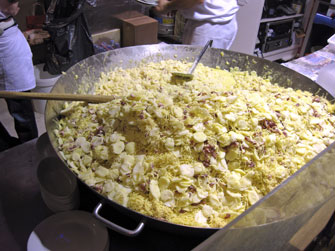
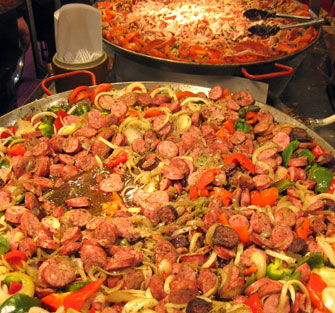
The mass of goo in the top photo is tartiflette, an Alpine dish that consists of Reblochon (a soft, rich cheese) melted over onions, potatoes and chunks of bacon, with some white wine for extra consistency and some heavy cream for extra lethality. Plus a kilo or two of butter so it doesn’t stick to the pan. It was on sale for €6 per portion (€8 with a defibrillator).
Many of my favorite specialty specialists from last year were not at this year’s Salon, but there was still a manureload of excellent food and drink to be had. I tried every free sample I could get my hands on and came away with purchases including, but not limited to, aiguillettes de canard (see my pre-C’est Ironique article about this superb duck-derived delicacy), a big jar of onion chutney, a jumbo jar of Espelette pepper purée, several liters of microbrewery beer (about half of it in my bloodstream) and enough cheese to choke the entire population of Pavilion 4.
I do have one product to recommend: a big, plump, pliable, asphyxiatingly smelly cheese from Picardy called Rollot, offered by the Fromagerie de la Chapelle Saint-Jean, Pavilion 7.1 stand N05. It has a great flavor and an odor that could be used for riot control.
So, with my shopping bag, camera memory, stomach and bladder full, and my wallet empty, it was time to bid goodbye to this ephemeral agrarian enclave and head back to the city, to forsake the bounty of the soil for the sterile concrete of… Oh, wait — I almost forgot one of the animal attractions!
Note to cat lovers: yes, there are cats at the Salon de l’Agriculture, also in Pavilion 4. I went by to check out the feline action on my way out and it was, well, decidedly feline:
I think I remember seeing this spotted tom in the stands at the sheepherding competition.
For actual useful information about the Salon de l’Agriculture, see the (English translation of the) fair’s Web site.
Reader Barney Kirchhoff writes: “Speaking of manure, David didn’t mention the parade of presidential candidates visiting the agricultural fair to kiss cows, skirt bulls, pat porkers, fleece sheep, goose goats, etc. Maybe that was a major part of that extra 50 tons. Didn’t see any pix of them of them squeezing udders, though one of them has a famous eye for such things.”
FavoriteAn album of David Jaggard’s comic compositions is now available for streaming on Spotify and Apple Music, for purchase (whole or track by track) on iTunes and Amazon, and on every other music downloading service in the known universe, under the title “Totally Unrelated.”
Note to readers: David Jaggard’s e-book Quorum of One: Satire 1998-2011 is available from Amazon as well as iTunes, iBookstore, Nook, Reader Store, Kobo, Copia and many other distributors.
